Want to sail from Pula, on the Istrian peninsula, Croatia, to Venice, Veneto County, Italy? That's a great idea.
But first things first? Which vessel are you choosing for your Adriatic adventure?
Motorboat or a sailboat?
Selecting the right vessel is one factor that can make or break a successful voyage from Pula to Venice.
A motorboat offers speed and often advanced navigation systems, making it ideal for those who prefer to arrive fast and in style.
On the other hand, a sailboat provides an authentic sailing experience, a closer connection to the sea, and is often more economical.
So, when planning, you must consider your budget and crew size.
However, in the end, personal preferences always prevail as each type of vessel has its own charm and challenges.
Best time of departure for a sailing trip from Pula to Venice
As you know, you must time your departure wisely if you want favourable sailing conditions.
The best months to sail from Pula to Venice are between May and September when the weather and the sea are calm. If you prefer quieter marinas and anchorages, avoid the peak tourist season, July and August.
Early autumn can also be pleasant, with fewer crowds and mild weather. But if you choose the post-season (or even sailing in early spring), monitor the weather forecast closely in the days leading up to your trip.
Careful route planning enhances your sailing experience and ensures you don't miss any exciting spots along the way.
Our advice is to plan your sailing course considering distance, potential stopovers, and all the sights that captivated your attention.
It's best to leave enough time for leisurely sailing and ample time for exploration.
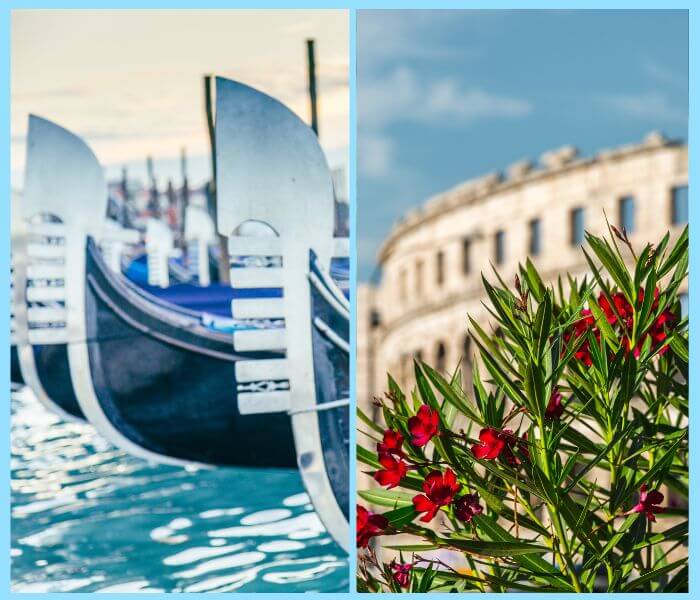
How long would it take to get from Pula to Venice by sea?
Depending on what vessel you are sailing with, you can arrive in Venice from Pula in just a few short hours or half a day.
If we want to estimate the sailing time for a 30-foot sailboat (approx. 9m) from Marina Tehnomont Veruda in Pula to Venice, we'll consider the average cruising speed and the distance in nautical miles. Which in this case is approximately 75nm.
A 30ft vessel can typically cruise at an average speed of around 5 to 6 knots.
Using these speeds, we can calculate the estimated time with this formula Time=Distance/Speed.
Therefore, sailing from Pula to Venice (75nm) in a 30ft sailboat will take approximately:
- 15 hours at 5 knots
- 12.5 hours at 6 knots
Using the same calculation formula Time=Distance/Speed, we can calculate different sail times for different sizes and types of motorboats:
- Less than 16 feet = 5 to 7.5 hours.
- 16 to less than 26 feet = 3 to 5 hours
- 26 feet to less than 40 feet = 2.5 to 3.75 hours
- 40 feet to less than 65 feet = 2.14 to 3 hours
These calculations are just estimates. They can vary depending on actual sailing conditions, such as wind, currents, and the specific performance of the vessel itself.
It also depends on how many stops you decide to make during the route – and we wholeheartedly advise you to do so.
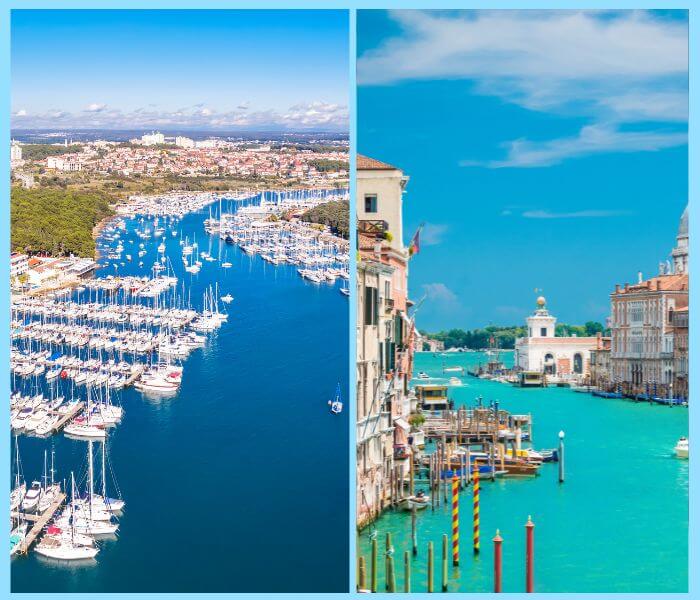
Starting point - Marina Tehnomont Veruda, Pula
Pula boasts several well-equipped marinas that cater to sailors, but Marina Tehomont Veruda is the most popular choice.
This is understandable, as this largest marina on the Istrian peninsula offers over 600 berths on 19 piers for vessels up to 40m and a maximum draught of up to 4m, as well as 250 dry dock berths.
Marina provides essential services such as fuelling stations, water, electricity, and maintenance support. It even has a charging station for electric vehicles, a swimming pool, a bar, laundry, a gas station and a general store.
Marina Veruda is also an environmentally friendly marina. It will surely meet all of your needs and ensure your vessel is fully prepared before departure.
Our advice:
- Before you set out, complete a thorough pre-sail checklist.
- Inspect your vessel's hull and rigging, check the engine, fuel levels, and all onboard systems, and securely stow all gear and provisions.
- Review your planned route and weather forecast one last time.
- Ensure all necessary documents, including passports and boat registration, are on board.
- Brief your crew on safety procedures and assign roles.
With everything in order, you can continue your Croatian/Italian adventure.
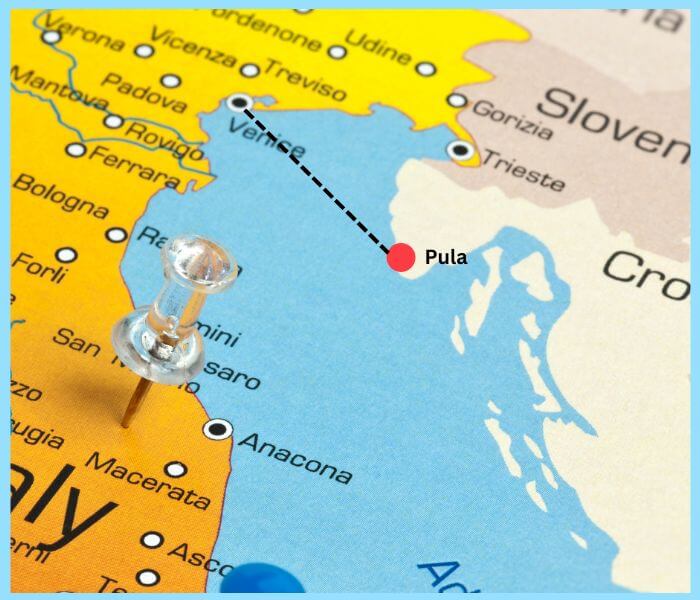
Direct sailing route from Pula to Venice, Italy
The most straightforward way to sail from Pula to Venice is a direct path across the Adriatic Sea, providing a memorable sailing experience.
Departure: Marina Tehnomont Veruda, Pula
Latitude: 44.8366°N
Longitude: 13.8377°
Arrival: Porto di Lido, Venetian Lagoon
Latitude: 45.4130° N
Longitude: 12.3660° E
Total Distance: Approximately 75 nautical miles.
Begin your journey at Marina Tehnomont Veruda in Pula.
Set a west-northwest course as you leave the marina and clear the local waters of Pula.
From Pula, chart a direct course towards Venice. The distance across the Adriatic Sea is approximately 75 nautical miles.
To head directly towards Venice, maintain a course of roughly 300° to 310° magnetic. Use GPS and nautical charts to stay on course.
Be prepared for open water conditions. Ensure you have a reliable weather forecast and keep an eye out for any sudden changes in weather.
Halfway across, you'll be in the middle of the Adriatic Sea. Use your navigation tools to check your position and course regularly.
Make sure all safety equipment is accessible, and keep regular watch shifts to stay alert for other vessels and changing conditions.
Aim for the Porto di Lido entrance, the main entry point into the Venetian Lagoon.
As you approach, follow the navigational markers (buoys and beacons) that guide vessels safely through the lagoon's channels. The lagoon can be shallow and tricky to navigate, so precision is the key.
The lagoon is a busy area with many boats, so adhere to maritime traffic rules. Choose a marina such as Darsena Le Saline, Venezia Certosa Marina or Marina Santelena. These marinas offer good facilities and easy access to Venice's attractions.
Arrival to the Venetian Lagoon and Venice
Navigating the Venetian Lagoon requires careful attention due to its shallow waters and heavy traffic.
Follow marked channels and be aware of tidal changes. As you approach, the lagoon offers stunning views of Venice's iconic skyline.
Our advice is to plan your arrival during daylight for easier navigation.
Venice offers several marinas and anchorages suitable for visiting sailors.
Darsena Le Saline 45°13′43″N - 12°16′81″E
Situated in Chioggia, this marina offers secure berths, is close to Venice, and is a great location for exploring the southern lagoon.
Venezia Certosa Marina 45°26′3.47″N - 12°22′24.37″E
This full-service marina is located on the island of Certosa and provides berthing, repairs, a restaurant, and even a sailing school.
Marina Santelena 45°25'37"N - 12°22'00E
Situated at the southeastern side of the island of Sant'Elena, close to the main entrance of the Venetian Lagoon, Porto di Lido. The marina is well-equipped with facilities, providing a tranquil setting away from the hustle and bustle of central Venice.
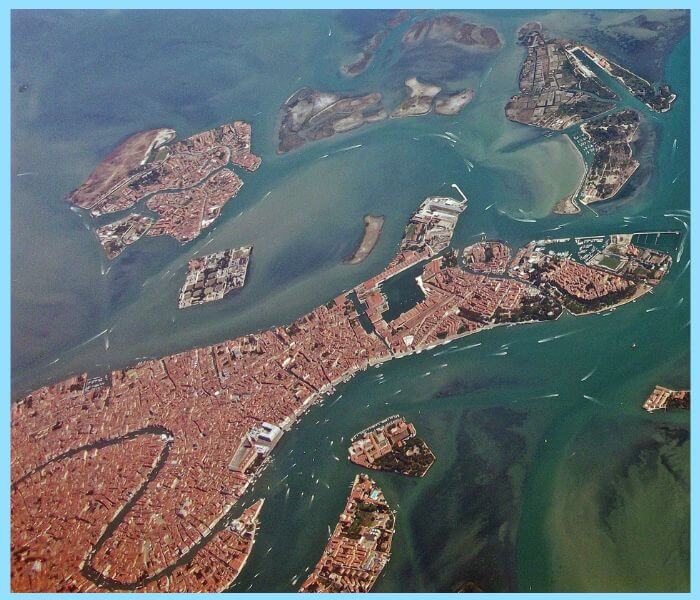
Top attractions to visit in Venice
There is no place like Venice. This town is a vast repository of attractions, from world-famous landmarks to lesser-known gems. We give you 10 attractions you simply must see, together with some lesser-known locations.
- St. Mark's Basilica: An iconic example of Italo-Byzantine architecture, known for its opulent design and stunning mosaics.
- Doge's Palace: A historic palace that was the residence of the Doge of Venice, showcasing Gothic architecture and Venetian history.
- Rialto Bridge: The oldest of the four bridges spanning the Grand Canal, famous for its architecture and nearby bustling market.
- Grand Canal: Venice's main waterway is lined with grand palaces and bustling with gondolas and vaporettos.
- St. Mark's Square (Piazza San Marco): The principal public square in Venice, surrounded by notable buildings such as St. Mark's Basilica and the Campanile.
- Scala Contarini del Bovolo: A hidden spiral staircase offering panoramic views of Venice, tucked away near Campo Manin.
- Libreria Acqua Alta: A unique and quirky bookstore famous for its creative book displays and gondola inside the shop.
- Campo Santa Margherita: A lively square popular with locals, offering a glimpse into Venetian daily life with cafes, markets, and bars.
- Arsenale di Venezia: A historical shipyard and armoury of the Venetian Republic, less frequented by tourists but rich in history.
- San Francesco della Vigna: A serene church and monastery with beautiful gardens, offering a peaceful retreat from the busy tourist spots.
As you are already in Venice and sailing nonetheless, you simply must visit Murano Island, located about 1.5 kilometres north of Venice.
Murano is renowned for its glassmaking - a centuries-old tradition. Numerous glass factories and studios are open to the public, where artisans demonstrate the intricate art of glassblowing.
The island also features the Murano Glass Museum, with a vast historic and contemporary glass art collection.

Navigating the coast of the Istrian peninsula
But before all - remember that the Istrian coast is dotted with charming towns and picturesque anchorages.
Pula, the most prominent city of the peninsula, is rich in history and culture.
Visit the Roman amphitheatre, one of the best-preserved ancient structures of its kind.
Stroll through the old town, where historical landmarks like the Temple of Augustus and the Arch of the Sergii reveal the city's past.
Enjoy the local museums that offer insights into Pula's maritime heritage.
The blend of Roman, Venetian, and Austrian influences makes Pula a fascinating starting point for your journey.
Along the (on your route to Venice), numerous small coastal towns will definitely enrich your sailing trip.
- Fažana: Known for its charming waterfront and gateway to the Brijuni Islands.
- Brijuni Islands National Park: serene landscapes and historical ruins.
- Rovinj: A picturesque town with narrow cobblestone streets and a vibrant cultural scene.
- Lim Fjord: perfect for a peaceful anchorage with its lush green surroundings.
- Vrsar: Offers a beautiful marina and stunning views of the archipelago.
- Poreč: Home to the UNESCO-listed Euphrasian Basilica and lively old town.
- Novigrad: Features a well-preserved medieval old town and excellent seafood restaurants.
- Umag: Famous for its historic architecture and as a host of international tennis tournaments.
Each stop provides unique experiences, from exploring ancient architecture to enjoying quiet bays.
Plan your route to include these spots and take all the time you need to soak in the local atmosphere.
Weathering the Adriatic - local wind and sea conditions
Every sailor knows how knowledge of local wind patterns and sea conditions is crucial for every sail expedition.
The Maestral, a reliable north-westerly wind, is favourable for sailing along the Istrian coast.
Be wary of the Bora, a strong northeasterly that can create challenging conditions.
The Jugo, a southerly wind, brings warmer temperatures and can cause rough seas. Check weather updates regularly and adjust your plans accordingly.
Deciding between night and day sailing depends on your preferences and experience level. Day sailing allows you to enjoy the scenery and navigate with ease. It's ideal for exploring coastal attractions and making frequent stops.
On the other hand, night sailing can be peaceful and offer a unique perspective of the sea. It also requires more skill and vigilance, particularly in busy marine traffic routes.
Our advice is to sail during the day and rest during the night. One reason is your safety, of course, but the other, as we mentioned before, is that you will better view and appreciate the scenery.
Check, check. 1, 2, 3 - don't sail out without a proper check
A safe and enjoyable journey implies safety to the utmost degree, especially for longer, across the sea, fares.
Ensure you have reliable GPS and nautical charts of the Adriatic Sea. Flares, life jackets, and a first aid kit are non-negotiable. Invest in a quality marine radio for communication.
Stock up on provisions, including fresh water, non-perishable food, and cooking supplies.
Don't forget personal items like sunscreen, sunglasses, and appropriate clothing.
Check your vessel's mechanical systems and ensure you have spare parts and tools for emergency repairs.
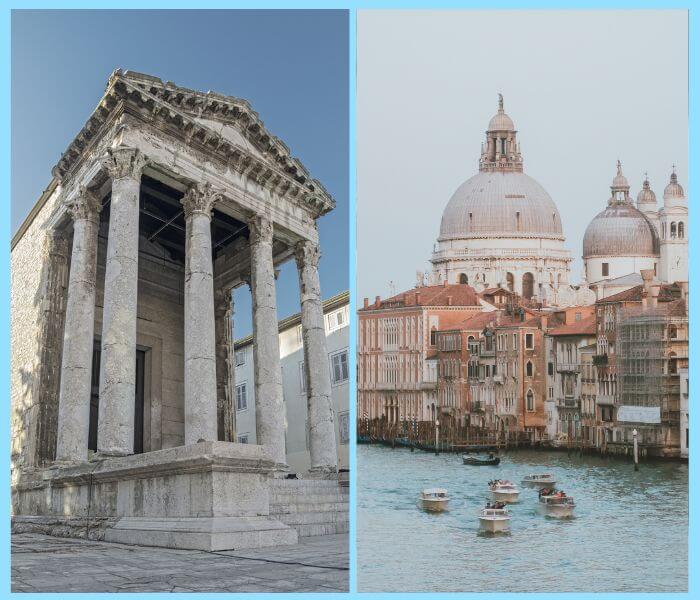
And one last thing – share your experience
Document your unique experience and share your journey with others.
Better yet, start a sailing blog detailing your route, challenges, and highlights. You can include photos and videos to bring your story to life. Offer practical tips and advice for fellow sailors. Your insights will benefit others planning similar trips.
Share your expedition on social media, and if you sailed with one of our vessels, please tag us.
We also want to preserve memories but also inspire future trips.
Need more information? Contact us with any inquiries, or simply book one of our vessels while they are available.


